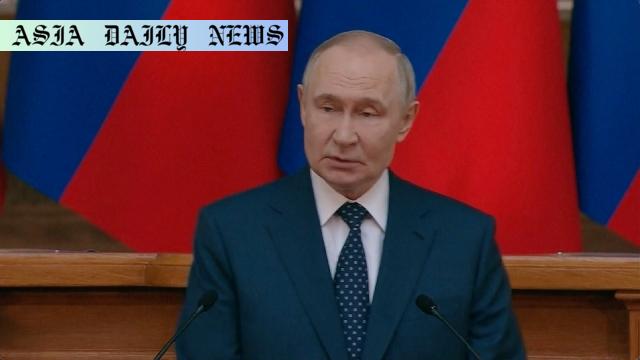ceasefire: Russian President Putin declares a three-day ceasefire on May 8-10 to commemorate the Soviet victory’s 80th anniversary.
Russian President Putin announced a three-day ceasefire from May 8-10.
The truce coincides with the 80th anniversary of Soviet victory over Nazi Germany.
Russia has urged Ukraine to join the ceasefire and halt hostilities during this period.

Putin Declares Three-Day Ceasefire in Ukraine Conflict
The ongoing war between Russia and Ukraine has taken a surprising turn as Russian President Vladimir Putin announced a unilateral three-day ceasefire. The truce, set to take place from May 8 to May 10, is aimed at marking a significant historical milestone—the 80th anniversary of the Soviet Union’s victory over Nazi Germany during World War II. This ceasefire declaration, encompassing 72 hours starting at midnight Moscow time on May 8, symbolizes a brief pause in the hostilities that have ravaged the region for over a year.
Significance of the 80th Victory Anniversary
May 9 is a revered holiday in Russia, celebrated as Victory Day. It honors the defeat of Nazi forces in 1945 and holds immense cultural and historical significance for Russians. The Kremlin stated that the ceasefire is a gesture of respect and commemoration for this historical event. By declaring this truce, President Putin aims to intertwine Russia’s modern-day conflicts with its storied past, signaling a momentary focus on unity and reflection.
A Call for Reciprocal Action
Alongside the ceasefire announcement, Russia has called upon Ukraine to join in the cessation of hostilities during the designated period. The gesture, though unilateral, highlights a potential pause in the war. However, questions remain about Ukraine’s response and whether this temporary truce may pave the way for broader peace talks or serve as merely a symbolic act. Analysts contend that the military and political implications of the ceasefire are vast and merit careful consideration.
The Humanitarian Impact of the Ceasefire
A 72-hour pause in fighting could bring much-needed relief to war-torn areas, allowing civilians to access critical resources, humanitarian aid, and medical care. This ceasefire could momentarily alleviate the severe living conditions faced by those in conflict zones. Furthermore, it presents an opportunity for both sides to reconsider their positions on sustaining prolonged violence, albeit briefly.
Criticisms and Questions Surrounding the Ceasefire
While the ceasefire announcement has been met with cautious optimism, it has also sparked criticism and skepticism from various stakeholders. Some view the truce as a political maneuver rather than a genuine step toward peace. Others question whether such an act can meaningfully address the deep-seated issues underlying the conflict. The international community remains watchful, waiting for actions to follow the words of commitment.
Looking Beyond the Three-Day Truce
As the world awaits the implementation of the ceasefire, its broader implications loom large. Will it encourage future dialogue between the warring nations, or is it merely a symbolic gesture tied to a historical event? The coming days will reveal the impact of this truce on the trajectory of the Russia-Ukraine war and the prospects for lasting peace in the region.



Commentary
A Ceasefire Amidst Conflict: A Positive Step or a Strategic Ploy?
The announcement of a three-day ceasefire by Russian President Vladimir Putin is a development that warrants both hope and skepticism. On the surface, it seems like a significant step toward de-escalating tensions in the ongoing Russia-Ukraine war. However, the motivations and potential outcomes of this truce require deeper analysis to understand its implications fully.
Commemorating History with a Ceasefire
May 9 holds immense cultural and emotional significance for Russia, as it celebrates the Soviet Union’s triumph over Nazi Germany in World War II. Tying the ceasefire to such a historical milestone adds a layer of symbolism to the gesture. It projects an image of honor and reverence for the past, possibly aiming to rally domestic support and highlight Russia’s historical narrative in the context of the current war.
The Skepticism of Symbolism
Despite its symbolic nature, the truce does not come without criticism. Many observers question whether the ceasefire is a genuine act of goodwill or a strategic move meant to serve political and military goals. Temporary halts in combat have historically been used to regroup and strategize. In this case, the 72-hour window might provide an opportunity for Russia to reinforce its position on the ground.
Potential for Humanitarian Relief
One cannot dismiss the potential positive impact of the ceasefire on civilians caught in the crossfire. The pause provides a crucial opening for delivering humanitarian aid, accessing medical services, and reconnecting displaced families. While limited in scope, such truce moments underscore the urgent need for lasting solutions to alleviate human suffering in conflict zones.
Final Thoughts
As the world watches these events unfold, the implications of the ceasefire stretch beyond the immediate cessation of hostilities. Whether this act sparks a broader conversation about peace or serves as a temporary reprieve remains to be seen. Nonetheless, it highlights the complex interplay of history, symbolism, and strategy in shaping the course of modern warfare.